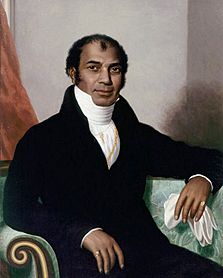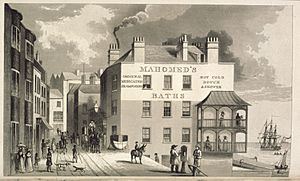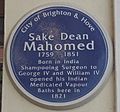Dean Mahomed facts for kids
Sake Dean Mahomed (born Sheikh Din Muhammad, 1759–1851) was an amazing Indian traveler, surgeon, and businessman. He was one of the first people from outside Europe to move to the Western world. Because he was from a different country, his name is spelled in many ways.
He brought Indian food and special "shampoo" baths (which were like massages) to Europe. He was also the first Indian person to publish a book written in English.
Contents
Early Life in India
Sake Dean Mahomed was born around May 1759 in Patna, a city in what was then British India. He came from a Bengali Muslim family. He said his family was connected to important rulers called Nawabs of Bengal and that his ancestors worked for the Mughal Emperors.
His father worked in the East India Company's army. Sadly, his father died in battle when Mahomed was about 11 years old. After his father's death, Captain Godfrey Evan Baker, an Anglo-Irish officer, took care of him.
Mahomed joined the East India Company's army as a trainee surgeon. He also fought in battles against the Maratha Empire. He stayed with Captain Baker until 1782. That year, Captain Baker left the army, and Mahomed decided to go with him to Ireland.
Moving to Europe and Family Life
In 1784, Mahomed moved to Cork, Ireland, with the Baker family. There, he went to school to get better at English. He met and fell in love with Jane Daly, a "pretty Irish girl."
At that time, it was against the law for Protestants to marry non-Protestants. So, Jane's family did not approve of their relationship. Mahomed and Jane went to another town to get married in 1786. Mahomed changed his religion from Islam to Anglicanism.
Later, around 1800, they moved to London, England. Sake Dean Mahomed had seven children with Jane Daly. Their names were Rosanna, Henry, Horatio, Frederick, Arthur, and Dean Mahomed. He also had a daughter named Amelia with Jane Jeffreys.
His son, Frederick, owned Turkish baths in Brighton. He also ran a place where people could learn boxing and fencing. Sake Dean Mahomed's most famous grandson was Frederick Akbar Mahomed (born around 1849). He became a well-known doctor in London. He made important discoveries about high blood pressure.
His Famous Book: The Travels of Dean Mahomet
On January 15, 1794, Mahomed published his book called The Travels of Dean Mahomet. The book is written as a series of 38 letters, which was a popular style for travel books back then.
The book starts by comparing Ireland and India. He then shares stories from his early life. He describes his travels between 1770 and 1775, when he followed the Bengal army around North East India. He writes about battles and big cities like Kolkata and Varanasi.
His book also gives a firsthand look at Indian culture, trade, and wildlife. It ends with his journey to Britain, where he arrived in September 1784. While Mahomed wrote about India in a kind way, he often saw things from a European point of view.
Historian Michael Fisher, who studied Mahomed's book, found that some parts were similar to other travel books from that time.
Opening England's First Indian Restaurant
In 1810, after moving to London, Sake Dean Mahomed opened the first Indian restaurant in England. It was called the Hindoostane Coffee House. It was located on George Street in Central London.
The restaurant offered special items like hookah pipes with real tobacco. It also served Indian dishes. Many people said his curries were the best they had ever tasted in England. However, the restaurant faced money problems and eventually closed.
Bringing "Shampooing" to Europe
Before opening his restaurant, Mahomed worked for a rich man named Basil Cochrane in London. Cochrane had a steam bath in his house for people to use. Mahomed might have helped introduce the idea of champooi or "shampooing" there. This was a type of Indian massage.
In 1814, Mahomed and his wife moved to Brighton. There, they opened the first commercial "shampooing" bath in England. It was a special vapor massage bath. He advertised it as "The Indian Medicated Vapour Bath." He said it could help cure many diseases and relieve pain, especially for problems like rheumatism, gout, and stiff joints.
His business was very successful right away. People started calling Dean Mahomed "Dr. Brighton." Hospitals even sent patients to him. He became the shampooing surgeon for two kings: King George IV and King William IV.
Mahomed wrote two books about his special baths. One was called Cases Cured by Sake Deen Mahomed (1820). The other, Shampooing; or, benefits resulting from the use of the Indian medicated vapour bath, was published three times (1822, 1826, 1838). He dedicated this book to King George IV.
In his book, Mahomed wrote about how some English people were unsure about shampooing at first. He said it was hard to introduce a new idea. But because his baths helped so many people, they became very popular.
Later Life and Legacy

Sake Dean Mahomed died on February 24, 1851, in Brighton. He was about 91 or 92 years old. He was buried in a grave at St Nicholas Church, Brighton. His son Frederick was later buried there too.
For a long time, Sake Dean Mahomed was not widely remembered. But in the last 50 years, people have become interested in his life and writings again. Scholars like Alamgir Hashmi and Michael H. Fisher have helped bring his story back to light. Rozina Visram's book Ayahs, Lascars and Princes also helped people learn about Mahomed.
In the 21st century, there have been several ways to remember Mahomed. On September 29, 2005, the City of Westminster put up a Green Plaque to remember the Hindoostane Coffee House. It is near where the restaurant used to be. On January 15, 2019, Google honored Sake Dean Mahomed with a special Google Doodle on their main page.
Images for kids
See also
 In Spanish: Sake Dean Mohamed para niños
In Spanish: Sake Dean Mohamed para niños







